Kenda Karrier S-Trail ST145/R12 Radial Tire w/ 12" White Spoke Wheel - 4 on 4 - LR D

 Arrives before Christmas
Arrives before Christmas 

- All Info
- Reviews (1477)
- Q & A (0)
- Photos
Kenda Trailer Tires and Wheels - AM35351DX
- 12 Inch
- Tire with Wheel
- 4 on 4 Inch
- 145/80-12
- Load Range D
- Steel Wheels - Powder Coat
- Radial Tire
- M - 81 mph
- Kenda
Radial tire with automotive-grade tread has an 8-ply rating and a 1,220-lb max load at 65 psi. 12" x 4" Steel wheel has a 4 on 4 bolt pattern and a corrosion-resistant white powder coat finish. Beveled stud holes keep wheel secure.
Features:
- Tire-and-wheel assembly is ideal for stock trailers, utility trailers, and campers
- Sturdy steel wheel with 8-spoke design by Dexstar
- White powder coat over e-coat primer for excellent corrosion resistance
- Beveled stud holes help to keep wheel securely in place on trailer hub
- Eliminate the need for constant retightening of lug nuts
- Karrier S-Trail radial tire
- Double steel belts and full nylon plies combine for superior function and long life
- Premium rubber compound materials help disperse heat
- Radial ply tire is great for highway use
- Automotive-grade, computer-generated tread has sipes that channel water away from the tire to improve traction during wet, snowy, or icy conditions
- Special trailer (ST) tire has sturdy sidewalls so that it can handle heavy loads
- Created specifically for trailers and not intended for use on other vehicles
- Assembly meets DOT specifications
- Wheel is made in the USA
Specs:
- Rim dimensions: 12" diameter x 4" wide
- Bolt pattern: 4 on 4"
- Wheel bolt size: 1/2"-20
- Wheel capacity: 1,250 lbs
- Pilot diameter: 2.84"
- Offset: 0
- Tire size: ST145/R12
- Section width: 5.7"
- Outer diameter: 21.3"
- Tire capacity:
- Load range: D
- Ply rating: 8
- Maximum load: 1,220 lbs at 65 psi
- Tread depth: 7/32"
- Maximum speed: 81 mph (speed rating M)
- Warranty:
- 5-Year on tire
- Limited 1-year on wheel
1-Year Worry-Free Guarantee
This tire has a 1-year worry-free guarantee. If within the first 12 months the tire is damaged in any way, it will be replaced at no charge.
Karrier S-Trail Radials with Automotive-Grade Tread

Unlike standard trailer tire tread, which has solid, continuous ribs, the automotive-grade, computer-generated tread on these Karrier S-Trail radials has ribs with breaks. These breaks allow water to run off to the sides. The Karrier S-Trail tread also has sipes. Siping is a process in which thin grooves (or sipes) are cut into the rubber of the tire. The grooves channel water away from the tread so that the tire makes better contact with the road. Both of these features greatly improve traction during wet, snowy, or icy conditions.
Karrier S-Trail radials are constructed with double steel belts and full nylon plies for increased durability and endurance. The premium rubber compound materials of this tire help disperse heat.
Beveled Stud Holes

The stud holes on this steel wheel are beveled to ensure that the wheel stays tight against your trailer hub. This also eliminates the need to constantly retorque the lug nuts.
Radial Tires vs. Bias Tires

Radial ply tires are designed for trailers that are towed on the highway. The cords on a radial tire are positioned at a 90-degree angle to the direction of travel so that they lay across the width of the tire from wheel lip to wheel lip. This construction prevents the cords from rubbing against one another when the tire flexes, unlike the cords on a bias ply tire. As a result, radial tires have less rolling resistance and heat buildup, which leads to a longer tread life and improved steering at higher speeds.
Determining the Bolt Pattern
The first number in the bolt pattern is the number of bolt holes. The second number denotes the diameter, in inches, of the circle on which the bolt holes sit.
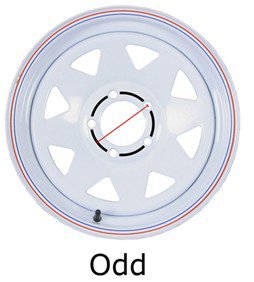
To determine the bolt-circle diameter on wheels with an odd number of bolt holes, measure from the center of any bolt hole to the point halfway between the two bolt holes directly across from the first. (Example: "5 on 4-1/2" means 5 bolt holes with 4-1/2" measured to a point halfway between the opposite bolt holes.)
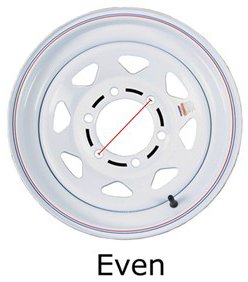
On wheels with an even number of bolt holes, measure from the center of one bolt hole to the center of the hole directly across from it. (Example: "8 on 6-1/2" means 8 bolt holes with 6-1/2" from the center of one hole to the center of another on the opposite side.)
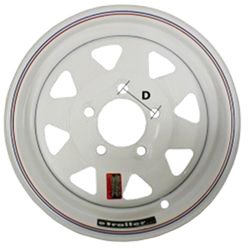
Measuring the distance from the center of one bolt hole on the wheel to the center of a bolt hole right next to it can also help to determine the bolt pattern.
- If D = 2-5/8", then the bolt pattern is 5 on 4-1/2"
- If D = 2-3/4", then the bolt pattern is 5 on 4-3/4"
- If D = 3", then the bolt pattern is 5 on 5"
- If D = 3-1/4", then the bolt pattern is 5 on 5-1/2"
35351 Kenda Karrier KR25 S-Trail ST145/R12 Radial Tire with 12" White Dexstar 8-Spoke Rim - 4 on 4 - Load Range D
Replaces Americana 35351DX
Customer Satisfaction Score:
96% were satisfied with this product
4% of customers were not satisfied
- Product did not meet expectations
- Wrong item was ordered
- Alternate product found
Ratings & Reviews
4.8
1477 reviews
Great delivery, great product.
See what our Experts say about this Kenda Trailer Tires and Wheels
- Can A Smaller Tire Be Put On My Trailer To Lower ItYes, you are able to put a smaller tire on the trailer to lower it, however there are a few things that you want to consider when choosing a smaller tire. According to my research the standard tires that are on your trailer are ST175/80R 13LRC tires with a 1360 pound capacity. It also has a 2200 pound rubber torsion axle with no brakes. This type of setup has either wheels with a 4 on 4 Inch # AM3S120 or a 5 on 4-1/2 Inch bolt pattern # AM31994. This is something to consider when choosing...
view full answer... - Upgrading From 20.5x8.0-10 To Larger Wheels/Tires On a TrailerIn regards to upgrading, which for most means going with a larger wheel/tire combo, this is possible but you will be limited by the bolt pattern of the hubs. The 4 on 4" bolt pattern will allow for wheel sizes from 8-13". The best size comes down to available space which is not really something I can give a recommendation on for any one particular trailer. That said, if you have room, the Kenda Karrier S-Trail ST145/R12 Radial Tire part # AM35351DX would be a great option. It measures...
view full answer... - Can 10 Inch Wheels be Replaced by 12 Inch Wheels on TrailerYou are smart to move to radial tires and you do not need to make any axle modifications on your trailer you only need to know your wheel's bolt pattern; if it is 4 on 4" or 5 on 4-1/2" you can simply replace your wheels with new 12" wheels. If you are unsure of what your bolt pattern is please take a look at the help article I have added which explains how to determine the bolt pattern of a trailer wheel. Keep in mind you also need to know your Coleman Sequoia's GVWR to get the proper...
view full answer... - Recommended Wheel and Tire To Replace 4.50-10 Tires On Concrete MixerWe have an option that will work perfectly for you. I recommend replacing the 4.50-10 tires on wheels that have the 4 on 4" bolt pattern with the Kenda 4.80-12 Bias Trailer Tire with 12" Galvanized Wheel - 4 on 4 - Load Range C # AM30630. This combination has wheels with the same 4 on 4" bolt pattern, and the tires will be .1" wider and will be right at 1.5" taller overall so you will have no issues based on the clearance you can see in the pictures you provided. Keep in mind that only...
view full answer... - How to Determine the Correct Over-Under Conversion KitIn order to determine whether you need the Dexter Trailer Springs Over-Under Conversion Kit # K71-384-00 (2-3/8") or # K71-385-00 (3") you will need to measure the diameter of your axle. If you get 2-3/8" then you need # K71-384-00 and if you get 3" then you need # K71-385-00. As far as tires/rims are concerned you will want to ensure you have a 4 on 4 bolt pattern (which is the most common 4 bolt pattern) I have included a link to an article that can help you with determining this. You...
view full answer... - Can You Upgrade From 18x8.50-8 Tires to 145/R12 Tires on 1976 Jayco Tent Trailer?You may be able to go from a 18x8.50-8 tire to a 145/R12 tire so long as the wheel has the same bolt pattern and you have enough clearance from the fender to the top of the tire; we generally recommend at least 3 inches of clearance from the top of the tire to the fender. We have 145/R12 tire and wheel combinations that may work for you. The Kenda Karrier S-Trail # AM35351DX has a wheel with a 4 on 4" bolt pattern and the Kenda Karrier S-Trail # AM31199DX has a wheel with a 5 on 4-1/2"...
view full answer... - How to Choose the Right Wheel Size for Trailer With 9 Inch WheelsThe wheels you have, while not common, are definitely a size used on trailers. These are 9" wheels that have a rim width of 4-1/2". When compared to a fairly common 8" wheel with a width of 3-3/4" or a 10" wheel with a width of 6" the size of your current wheels isn't anything unusual. I would recommend sticking with the wheels you have now. Although I don't know how many axles you have or the specific hubs on the trailer, more than likely they have enough capacity unless someone added...
view full answer... - Recommended Replacement Wheels & Tires for an Older Motorcycle Cargo TrailerHey David I do believe such a beast exists. It sounds like you're looking for something like the Kenda Karrier S-Trail ST145/R12 Radial Tire # AM35351DX. These is a wheel/tire combo that is white in color, measure 12" x 4", works with a 4 on 4 bolt pattern, and has an M speed rating which is rated at 81 MPH. What kind of motorcycle do you have? Let me know if you have any other questions and I'd be happy to help!
view full answer... - Replacement Tires for Harbor Freight 4x8 TrailerHi Jeff; the Taskmaster 4.80R12 Radial Trailer Tire # TT48012C will fit the Dexstar Steel Spoke Trailer Wheel # AM20122 you ordered. This is the same tire size you have now so clearance isn't an issue. It also has the M speed rating for 81 mph. I don't think you're going to find anything that is rated higher in the smaller size. Keep in mind, the trailer itself might not be rated that high. Even if you switch to higher rated tires you may be limited by the max speed of that trailer.
view full answer... - Can Trailer with 10 inch Bias Ply Tires be Converted to RadialIn the 10 inch trailer tire size there are only bias ply options available. To switch to radial you'd need to bump up to the 12 inch size which would require a new wheel as well like the part # AM31202 for if you have a 5 lug bolt pattern or # AM35351DX for if you have a 4 lug bolt pattern. You'd only lose about 1/2 inch of fender clearance going with the larger size.
view full answer... - Replacement 12 inch Trailer Wheel and Tire for Harbor Freight TrailerHey James, based on what you listed having on your Harbor Freight trailer the Kenda Karrier S-Trail ST145/R12 # AM35351DX would work great as its the same size wheel and bolt pattern and the tire is a radial like you are wanting. The Load Range of the tire is D which is higher but that just means it has a higher weight capacity at 1,220 lb at 65 psi. Are you wanting a radial for improved speed rating or handling?
view full answer... - Carlisle 145R12C Snowmobile Trailer Tire Replacement OptionsHey Corey, thanks for reaching out. We do have the 145/80-12 tires available, but our will be a load range D or E, so a thicker ply than the Carlisle C range tires you have now. We do not have any C range options, but the D or E range can certainly still work for you. If you need just the tires, here is what I recommend: - Kenda Karrier S-Trail ST145/R12 Radial Trailer Tire - Load Range D # AM10130 - Kenda Karrier S-Trail ST145/R12 Radial Trailer Tire - Load Range E # AM10140 We also...
view full answer... - Replacement 12 inch Wheel and Tire for Snowmobile Trailer Carrying Honda Goldwing 1,300 lbHey Robert, the Kenda Karrier S-Trail ST145/R12 Radial Tire w/ 12" White Spoke Wheel # AM35351DX would be a great option. This has a 1,220 lb per wheel/tire capacity so with two you'd have nearly twice the needed capacity, the tire has an 81 mph speed rating, and it has the 4 lug bolt pattern you need as well. Can your Goldwing do a wheelie??
view full answer... - Replacement Wheel and Tire for Forest River Pop Up 176SDHey Jim, if you have a 4 lug bolt pattern the Kenda Karrier part # AM35351DX would be a really great option or if you have a 5 lug pattern the part # AM31199DX. These are both on white wheels, does that color work for you?
view full answer... - Is There A Maximum Speed Rating For A Trailer Axle?A trailer axle like part # e25GR does not have a designated speed rating. The tires that you use with this axle will be the determining factor for a speed rating. For example, the Kenda Karrier Radial Trailer Tire # AM35351DX is commonly used with the # e25GR axle. These tires have a maximum speed rating of 81 mph (speed rating M).
view full answer... - Larger Wheel and Tire Options To Improve Highway Speed Rating For Harbor Freight Trailer 4.8-8 TiresThe 4.8-8 tires on your Harbor Freight trailer are most likely like the Kenda # AM10004 tires with a 55mph speed rating. We do have the Kenda 4.80-12" # AM30540 tires which have a higher speed rating of 65mph. Do note the tires are much taller at 20.5" in diameter versus only 16" which you have now so you will have to modify the fenders to make everything fit. A better option if you can make them fit is to use the Kenda Karrier S-Trail ST145/R12 Radial Tire w/ 12" White Spoke Wheel #...
view full answer... - Replacement Tires for 2011 Jayco Jay Sport 8Typically when it comes to replacing a trailer tire I recommend sticking with the same size. Although I do not know the weight capacity of your current tires, we do have the Taskmaster 5.30R12 Radial Trailer Tire - Load Range C # TT53012C. This radial tire has a maximum load of 1,050 lbs at 80 psi with a max speed of 81 mph. It looks like your trailer has a GVWR of 1,995 lbs so these tires will handle that without any issues. Because of the tire size, it is also possible to go to a 145/80-12...
view full answer... - Recommended Trailer Tire Upgrade for 4.80-12 Size TiresIf you want to keep the same size tire then I recommend going with the Taskmaster 4.80R12 Radial Trailer Tire # TT48012C. This is a radial tire (better for highway use than bias) with a load rating C (990 lbs at 90 psi) and a max speed rating of 81 mph. This tire does fit 12" x 4" rims though so if you truly do have a 3-3/4" wide rim (measured from bead seat to bead seat) then you will also need to use a different wheel. If this is the case then I recommend going with the Kenda Karrier...
view full answer... - Can 205/65-10 Tires be Upgraded to a Larger Size For Greater Ground ClearanceIn order to find if your 205/65-10 tires like the # AM3H410 can be upgraded to a larger size without modifying your camper you will need to take a few things into account. This will largely depend on what size tire you would like to add and how much additional ground clearance you are looking for. The first is your current bolt pattern. For example, if you wanted to use a 145/80-12 tire like the # AM35351DX and you currently have a 4 on 4 bolt pattern you wouldn't have an issue finding...
view full answer... - Can A 4.80-12 Tire Be Replaced With A ST145/R12 TireYes, The Kenda Karrier S-Trail ST145/R12 Radial Trailer Tire # AM10130 will fit the same 12 inch wheel with a 4 inch width that your existing 4.80-12 size tires are mounted to. The ST145/R12 tire will be about 0.8 inches larger in diameter, so you will want to make sure you have the necessary clearance on your trailer for the slightly larger tires. The Kenda radial tire has a ply rating 8 and has a maximum load at 1,220 pounds at 65 psi. The maximum speed of the tire is 81 mph with a...
view full answer... - Recommend Radial 5.30x12 Tire Upgrade for TrailerThe Taskmaster 5.30R12 Radial Trailer Tire part # TT53012C is our best radial trailer tire option in this size. The radial plies will keep the tire cooler on the highway which reduces the chance for blowouts. It also has a higher speed rating than the equivalent bias ply so you can travel at speeds up to 81 mph without issue. The 1,050 lb weight rating will exceed the current setup as well so there will be no issues there either. Please note, we don't have any good combo packages for...
view full answer... - Needing a Trailer Tire That Can Handle a Long Trip at 60 to 65 MPHThe Kenda 8 inch Tire and Wheel, # AM30153, that you referenced can travel at max speed of 65 mph. This wheel and tire has a 4 on 4 inch bolt pattern and can carry its maximum load of 1,075 lbs at 100 psi. The tire has a bias construction and an 8 ply rating. If your trailer and boat fall under these weight capacities and the bolt pattern is the same, then this wheel and tire will work for your trip with your jon boat. If you have the clearance on your trailer, I recommend upgrading to...
view full answer... - Recommended Replacement For 4 on 4 5.70-8 Trailer Wheels With A Higher Speed And Load Rating Hey Austin, For a 5.70-8 tire size on with a 4 on 4 bolt pattern we offer a Load Range D, but don't have a higher speed rating than K (65mph). To get the increased speed rating you'd need to go to a larger size tire like 215/60-8, which would be quite a bit wider than your current wheels so you'd have to replace both the tire and wheels with something like the # AM98NR. This would be 18.3" in overall diameter and 8.9" wide so you'll need to verify if you'll still have at least 3" vertically...
view full answer... - Torque Value for Kenda Karrier ST145/R12 Tire with White Spoke Wheel AM35351DXThe torque specifications for the lug nuts while using the Kenda Karrier S-Trail ST145/R12 Radial Tire w/ 12" White Spoke Wheel part # AM35351DX will be between 75-85 ft. lbs. In order to protect from theft I also highly recommend using the Wheel Lock Set for 1/2" Wheel Bolts part # RG01-150. We also have the Americana Trailer Wheel Lug Nut part # AM26NR for the other studs.
view full answer...
Do you have a question about this Trailer Tires and Wheel?
Info for this part was:











At etrailer.com we provide the best information available about the products we sell. We take the quality of our information seriously so that you can get the right part the first time. Let us know if anything is missing or if you have any questions.





























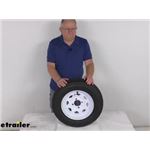




















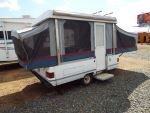
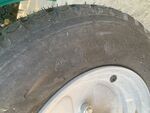
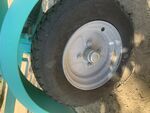
Thank you! Your comment has been submitted successfully. You should be able to view your question/comment here within a few days.
Error submitting comment. Please try again momentarily.